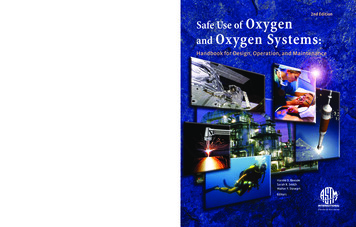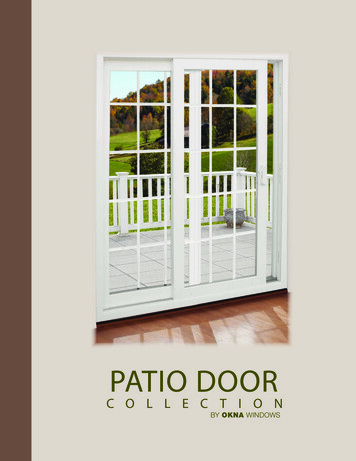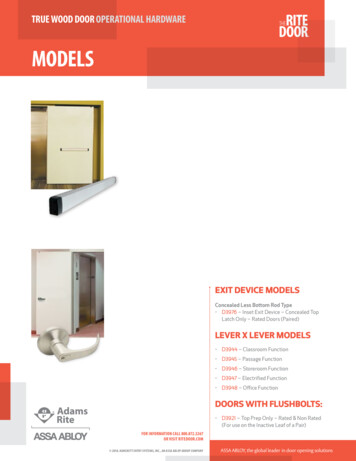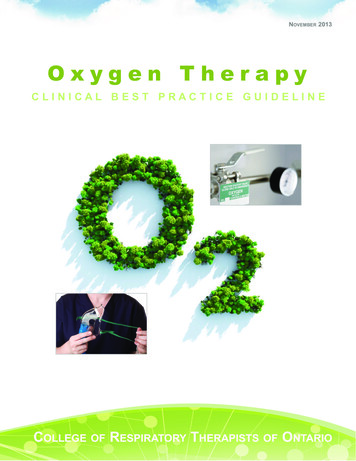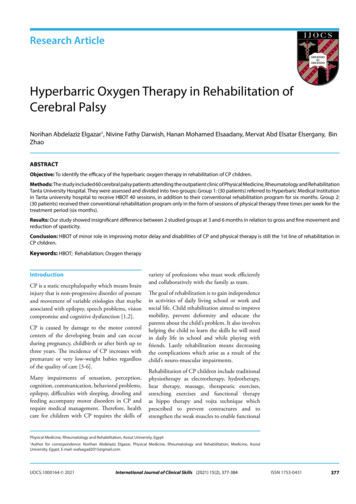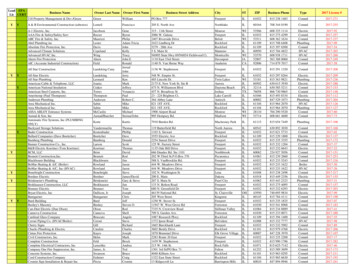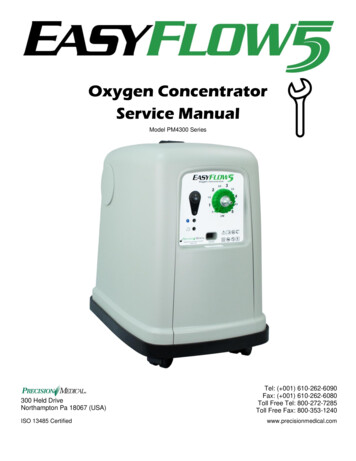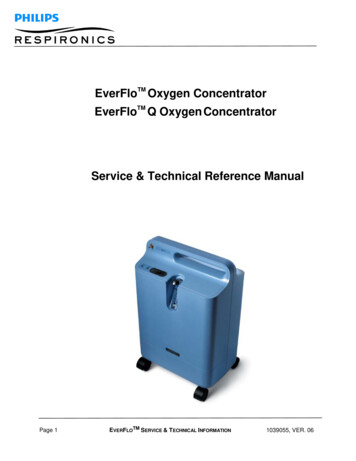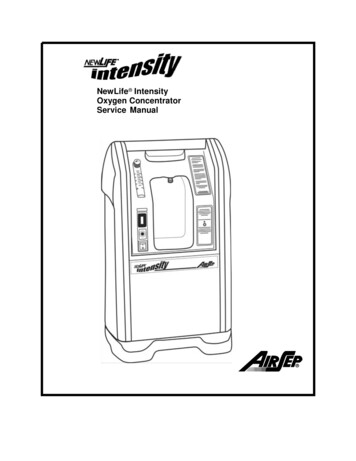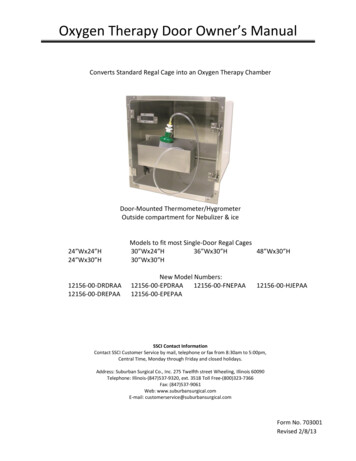
Transcription
Oxygen Therapy Door Owner’s ManualConverts Standard Regal Cage into an Oxygen Therapy ChamberDoor-Mounted Thermometer/HygrometerOutside compartment for Nebulizer & ice24”Wx24”H24”Wx30”HModels to fit most Single-Door Regal x30”H12156-00-DRDRAA12156-00-DREPAANew Model PAA12156-00-HJEPAASSCI Contact InformationContact SSCI Customer Service by mail, telephone or fax from 8:30am to 5:00pm,Central Time, Monday through Friday and closed holidays.Address: Suburban Surgical Co., Inc. 275 Twelfth street Wheeling, Illinois 60090Telephone: Illinois-(847)537-9320, ext. 3518 Toll Free-(800)323-7366Fax: (847)537-9061Web: www.suburbansurgical.comE-mail: customerservice@suburbansurgical.comForm No. 703001Revised 2/8/13
Page 1Care & Cleaning of Stainless Steel IntroductionStainless steel is steel alloyed with chromium to make it highly resistant to stain, rust andcorrosion. Note: This does NOT mean that stainless steel will never rust or corrode. Science has not yetdeveloped a steel which is completely stainless or corrosion PROOF.The type of stainless steel and finish selected by SSCI for the Oxygen Therapy Door is the bestavailable for the intended use.Cleaning & CleansersThe basic rule of thumb is to use the mildest cleaning procedure that will do the job effectively.Always rinse thoroughly with clear water, and dry completely. Frequent cleaning will prolong the servicelife of stainless steel equipment and will help maintain a bright, pleasing appearance.Ordinary deposits of waste and fluids can usually be removed with soap and water. Morestubborn deposits or tightly adhering debris may require harder scrubbing. They also may possiblyrequire the use of commercial cleaning products acceptable for use on metal surfaces. When using anycleaning agent, rub in the direction of the polish lines or “grain” of the metal. For high luster finishes,clean soft cloths or pads should be used. If especially rough cleaning is necessary, use “stainless steel”wool, nylon or plastic scrubbers. Test these scrubbers in an inconspicuous area first to be sure they donot mark or scratch the stainless steel finish.Minor scale build-up and some hard water spotting may be removed by washing with somevinegar, followed by a neutralizing rinse with clear water. A thorough drying with a soft cloth shouldfollow. For heavy deposits of scale, 5% oxalic acid (use warm), 5-15% sulfuric acid, or 5-10% phosphoricacid may be used. Always follow with a neutralizing rinse of clean water and a thorough drying.Deodorizing Agents, Disinfectants & SanitizersThe large selection of brands and combinations of chemicals available for deodorizing,disinfecting and sanitizing is staggering. Select one or more agents for use in your facility only afterweighing in all the benefits claimed by each product. Often this choice is made without adequateconsideration of the effects these agents may produce on equipment or furnishings.CAUTION: Before selecting a chemical to employ in your facility, review label statements regardinguse with metals (stainless steel). Always consult the chemical supplier if there are any doubts.Avoid prolonged use of chlorides (such as chlorine bleach), bromides, iodides and thiocyanateon stainless steel surfaces as these chemicals will cause pitting, corrosion and metal discoloration.Allowing salty solutions to evaporate and dry on stainless steel may also contribute to corrosiveconditions. In summary, select chemical deodorizers, disinfectants and/or sanitizers only after weighingin all possible outcomes and known adverse effects.Clear Polycarbonate Cleaning ProceduresRinse the polycarbonate window with clear water and dry thoroughly with a clean, soft cloth.Note: NEVER power-wash the Oxygen Therapy Door.Ice Tray Cleaning ProceduresThe ice tray should be removed and washed periodically - at least weekly. With heavy use, morefrequent washing may be necessary. Wash the tray in hot, soapy water, rinse with hot clear water, thendry thoroughly with a clean, soft cloth. Open the valve and make sure it is completely cleaned andflushed. Open and close the valve several times to make sure it operates freely.Nebulizer Cleaning ProceduresThe nebulizer and bottle should be removed and washed periodically - at least weekly. Withheavy use, more frequent washing may be necessary. Wash both items in hot, soapy water, rinse withhot clear water, then dry thoroughly with a clean, soft cloth. Rotate the regulator collar back and forthto make sure it operates freely.www.SuburbanSurgical.com
Page 2Chapter 1 - General InformationIntroduction .About Owner’s Manual .Information & Safety Notices .“Warnings”/”Notes” .Models .Warranty.Chapter 2 - Installation & SetupUnpacking & Inspection .Parts Included.Tools Required .Procedure .Chapter 3 - Operating & CleaningOpening & Closing .Latch Adjustment .Ice Tray.Gauges General Information.Cautions .Maximum/Minimum Temperature & Humidity Recording .Changing Between C & F Displays .Replacing the Gauge Battery .Using the Nebulizer .Oxygen Concentration Control .Chapter 4 - Repairs & ReplacementsReplacement Parts .General Information .Parts Ordering Procedure .Nebulizer Assembly, Complete .Tool Required.Procedure.Nebulizer Assembly, Partial .Nebulizer Oxygen Supply Hose .Nebulizer Hose Barb Fitting .Tools Required .Procedure.Nebulizer Extension .Nebulizer Cotter Pin.Gauge Assembly.Tools Required .Removal - New-style Gauge .Installation of New-style Gauge .Ice Tray .Ice Tray Valve .Tools Required .Procedure .Chapter 5 - TroubleshootingGeneral Problems .Returning the Oxygen Therapy Door for Repairs 01111111111121212121212121213141414141515
Page 3RMA Numbers.Packing & Shipment .Remedial Actions There is no oxygen flow into the cage.There is excessive oxygen leakage from the cage.The door does not close or latch correctly .One or both of the gauges does not read correctly .www.SuburbanSurgical.com15151616161616
Page 4CHAPTER 1-General InformationIntroductionThe SSCI Oxygen Therapy Door transforms your standard Regal Cage into an oxygen therapychamber. The clear door features a continuous-flow nebulizer with .25 in (.635 cm) inner diameter x.062 in (.16 cm) thick tubing to deliver a regulated flow of medicated, moist oxygen. Oxygen TherapyDoors are available for 24”W x 24”H, 24”W x 30”H, 30”W x 24”H, 30”W x 30”H, 36”W x 30”H, and 48”Wx 30”H single door Regal stainless steel cages. Unlike Regal Cage Doors, the Oxygen Therapy Door canonly be hinged on the left side and open from the right. A thermometer/ hygrometer mounted on thedoor monitors cage temperature and humidity for optimal treatment. The clear polycarbonate doorallows you to view the animal at all times. A detachable compartment on the outside holds the oxygennebulizer and ice to cool the oxygen if needed. The door mounts onto the front of the cage in place ofthe regular door, and uses standard hinges and latches to close securely. This new style door fits andaligns closer and tighter than the older styles, therefore not needing the rubber seals around the OxygenTherapy door. This new style door still vents out the CO2 from the cage as new Oxygen is introduced.About Owner’s ManualEvery attempt has been made to insure that the information in this manual is correct andcomplete. SSCI, however, always welcomes our customer’s suggestions for improvements to ourproducts and associated publications.Information & Safety NoticesThroughout this manual you will find text under the headings Note: and WARNING:. The textfollowed after “Note:” will assist you with additional information about the subject being discussed. Thetext followed after “Warning:” is there to alert you to potentially hazardous conditions which, if ignoredor mishandled, could result in injury to yourself, or damage to the equipment.Example:Warning: Oxygen is a highly combustible gas. Avoid the use ofopen flames, smoking materials, or equipment capable ofproducing sparks in any area in which oxygen is being used.Example:Push the Oxygen supply hose onto the new fitting. Note: Asmall amount of grease on the barbs will ease the assembly.ModelsThe SSCI Oxygen Therapy Door is available in eight different models, based on regal cage sizes.Note: Dimensions shown in Table 1 are cage sizes.TABLE 1New P/NDimensions (in)Dimensions H121.92Wx76.20Hwww.SuburbanSurgical.com
Page 5WarrantySuburban Surgical Company, Inc. warrants the original purchaser that our products are of thehighest standards in material and workmanship. Our stainless steel components are guaranteed to last alifetime assuming they are used as intended, properly maintained and cared for. Mechanical, electrical,electronic, hydraulic, and any product’s devices carry a one year warranty. Items purchased by SuburbanSurgical Company, Inc. from other manufacturers and incorporated into our equipment are covered bythe respective manufacturer’s warranties. Warranties will not apply if it is determined by SuburbanSurgical Company, Inc. that the equipment became defective due to an accident, misuse, abuse,improper maintenance or alteration. Warranty freight charges are covered for the first year only.www.SuburbanSurgical.com
Page 6CHAPTER 2-Installation & SetupNebulizer with supply tubingUnpacking & InspectionParts IncludedThe following parts are included in the shipment (Figure 1):1) Oxygen Therapy Door 3) Nebulizer with supply tubing2) Ice Tray with valveTools Required·Phillips Screwdriver, ·Punch (1/4in. dia. max), ·Small Hammer or MalletOxygen Therapy DoorIce TrayWith ValveFigure 1Procedure1. With a ¼ in. or smaller punch and a small hammer, remove both hinge pins from the cage door(Figures 2 and 3).2. Remove the door from the cage3. Hang the oxygen therapy door on the existing cage hinges and install theoriginal hinge pins (Figure 3).4. Open the door and on the rear of the gauge, pull the tape marked“REMOVE TO START” from the battery compartment. The gauge willHingesbegin operating.5. Hang the ice tray on the button hooks provided on the door (Figures 4and 5).6. On the Nebulizer extensions, squeeze the two ends of the cotter pinFigure 2: Hinges on Regal Cagetogether and remove the pin from the extension (Figure 6).7. Open the Oxygen Therapy Door.8. Place the Nebulizer in the ice tray with the extension through the openingHinge Pinin the door (Figures 5, 6 and 7). The hose end goes through a holder that(Shown partiallyshould be on the top left near the gauge.out)9. Inside the door, replace the cotter pin through the extension to hold thenebulizer in place and spread the two cotter pin ends apart to keep theHingepin from falling out.10. Attach the free end of the nebulizer plastic tubing to a 50 psi wall oxygenoutlet or an oxygen cylinder. Note: Your oxygen supplier is the best source Figure 3: Door Hinge & Hinge Pinto make this connection for you.11. Installation and setup is complete. Your SSCI Oxygen Therapy Door is nowready for use.OpeningforNebulizerExtensionIce TrayButton HooksFigure 4: Button HooksCotter PinIce TrayExtensionFigure 5: Ice Tray in placeFigure 6: Nebulizerwww.SuburbanSurgical.comFigure 7: Nebulizer in place
Page 7CHAPTER 3-Operating & CleaningWarning: Oxygen is a highly combustible gas. Avoid the use of open flames,smoking materials, or equipment capable of producing sparks in any area in whichoxygen is being used.Bracket ScrewBracketLatch ConnectorLatch ConnectorFigure 8: Door Latch & AdjustmentsFigure 9: Front View-Latch ConnectorOpening & ClosingThe door is held closed by a self-actuating latch connector (Figure 9). As the door is closed, thelatch connector rides up and over the handle, then falls down, locking the door closed. To open thedoor, lift up on the latch connector and pull the door open.Latch AdjustmentIf the latch connector and door are not properly adjusted, you may have difficulty in opening thedoor, and it may not lock automatically when closed. To adjust the door, loosen the bracket screws(Figure 8), move the brackets slightly up or down as needed, then retighten the screws. Try the dooragain, and repeat the adjustment until the latch connector and latch work together smoothly. If theabove adjustment is not adequate, you may have to loosen the screws on the door hinge brackets andmove the entire door up or down slightly.Ice TrayThe ice tray can be used for ice baths, warm water, warm chemical packs – whatever yourcurrent treatment requires. The tray cannot be easily removed from the door if the nebulizer is in place.Therefore, a valve is provided on the bottom of the tray to facilitate the disposal of used water (Figure10).The valve handle positions are:1.HorizontalClosed-No Flow2.VerticalOpen-FlowYou can attach a piece of .375 in. ID. tubing to the barbed tubing connection on the valve. Thiscan help drain the tray to a remote location.Figure 10: Ice Tray ValveHandle: Horizontal-No FlowVertical-FlowBarbed Tubing Connectionwww.SuburbanSurgical.com
Page 8Gauges General InformationA two-function, digital gauge is located on the upper left of the oxygen therapy door (Figure 11).This battery-powered gauge includes a thermometer and a hygrometer to allow you to monitor cagetemperature and humidity for optimal treatment conditions. Inaddition to displaying current conditions, the gauge featuresMax/Min readouts with memory, and the ability to displaytemperature in Centigrade or Fahrenheit. Temperature Range: -58 -158 F (-50 to 70 C) Temperature Accuracy: /- 1.8 F (1 C) Humidity Range: 10 - 99% R.H. Humidity Accuracy: /- 5%Figure 11: Temperature/Humidity GaugeCautionsDo not attempt to take the gauge apart. Use only the recommended battery type. Do notexpose the gauge to water or any other liquids. Dispose of old batteries only in accordance with localregulations.Maximum/Minimum Temperature & Humidity RecordingAs the gauge operates, it records the maximum and minimum temperatures and the humidityreached since the last time the “Clear Button” was pressed. Use a small pointed instrument, or anunbent paper clip, to press the Max /Min Button (Figure 12) on the gauge. Press once to read themaximum, and once again to read the minimum. Press the button a third time to return to the currentreading. The gauge shows MAX or MIN when either of these values is displayed. Press the Clear Button(Figure 12) to delete the previous maximum and minimum readings and begin recording new ones. C &̊ F Slide SwitchMax/Min ButtonClear ButtonFigure 13: Changing Between C & FFigure 12: Gauge ButtonsChanging Between C & F DisplaysA slide switch on the front side of the gauge (Figure 13) allows you to select between Centigrade and Fahrenheit temperature readings. Slide the switch UP to select Centigrade; and DOWN to select Fahrenheit.Figures 14: Gauge Battery Slide & BatteryReplacing the Gauge BatteryThe gauge is powered by a 1.5 AG 10 volt, lithium, Type LR1130Battery Slidebutton cell battery which you can obtain locally. The battery is contained ina built-in slide in the top of the gauge (Figure 14). Just pull the battery slideBatteryup with your finger to open, and remove the battery. When replacing thebattery, notice that the battery is marked with a “ ” sign on one side(Figure 15). The “ ” sign must be must face the front of the gauge. Withthe battery in the slide, press the slide downward until it clicks into place.www.SuburbanSurgical.com
Page 9Using the NebulizerWe at SSCI are not licensed veterinarians. Please use your experience, and refer to professionalliterature for advice on proper dosages and usage
Feb 08, 2013 · P a g e 1 www.SuburbanSurgical.com Care & Cleaning of Stainless Steel Introduction Stainless steel is steel alloyed wit
